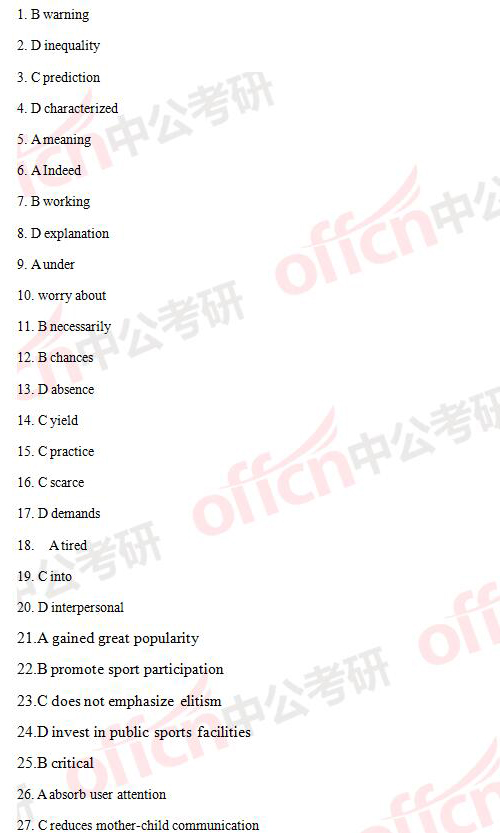1998-2022 ChinaKaoyan.com Network Studio. All Rights Reserved. 滬ICP備12018245號
2017考研英語二真題答案(圖片版)


2017年考研進行得如火如荼,此次英語二考的大作文是曲線圖,雖然以往沒有考過這類型的圖表,但是難度并不大。
這種圖形寫作與2010、2011所考的柱狀圖寫法有很大相似之處,都是有關一定時間段內數量變化的類型,可以說是換湯不換藥。該圖表涉及內容是參觀博物館的人數變化數據,關鍵詞也不難寫,故此從難度上看,屬于中低難度。
圖中的關鍵詞,博物館(museum)是中學詞匯,有基礎能力的同學可以相對輕松把握;博物館參觀者用簡單的visitors即可;至于圖表中的數字是十萬,6378個十萬即6.378 billion.
范文如下:
The statistics about museums and their visitors are precisely illustrated by the line chart. During the 3 years from 2013 to 2015, the figure of museums experienced a gradual rise, and soaring from 4.145 thousand to 4.692 thousand. Besides, following the same tendency, the number of museum visitors, as is shown, ascended gradually from 6.378 billion to 7.811 billion, increasing by about 1.43 billion.
The following factors, from my perspective, are responsible for the statistics. To begin with, aside from disseminating knowledge in schools, department concerned adopts other ways to promote the comprehensive quality of Chinese citizens, for instance providing more access to museums is a simple yet effective way to broaden visitors’ horizon. In addition, having been experiencing the unparalleled material prosperity, most of Chinese citizens intend to pursue knowledge by visiting museums, tourist attractions and other places. Moreover, museums, which are supported by public funding, provide visitors with knowledge and professional service. Individuals, therefore, are inclined to enjoy their leisure time by visiting museums.
To summarize, the data shown by the chart objectively reflect what’s happening in our society. Museums undoubtedly exert indispensible effects on our society and Chinese citizens, and it is predictable that, in the next decade, both large cities and small towns will witness the popularization of museums.
2017年考研英語二,小作文考察的是一封邀請信的回函,要求寫作內容包括:
1、接受教授邀請給留學生做有關中國文化的presentation(介紹/演示)。
2、提供介紹內容的關鍵信息。
考官出題的套路并不好預測,和往年一樣,讓想依靠背模板來過寫作關的同學眼前一黑,這完全證實了考研英語反押題反模板的一貫思路。不過從內容上看,寫作手法也秉承了以往考研英語二小作文的思路----多種文體結合。
此次寫作完全可以寫成一個感謝開頭結合內容介紹的格式,思路簡單但操作略有難度。寫作過程中最難的地方在于有關中國文化的關鍵信息,對考生的基本功有一定要求。
小作文
Dear Professor Williams,
It is my honor to receive your invitation to give presentation about Chinese culture to international students. And I am writing to express my heartfelt gratitude and provide the specific information about my presentation, which is about the brief introduction of Confucianism, the dominant philosophy of oriental culture.
To begin with, the first part of my presentation is the brief introduction to Master Confucius and the Analects of Confucius. Relevant background about Spring and Autumn warring state period will also be introduced. In addition, the second part is about etiquette, one of the cores of Confucianism, which stabilized ancient Chinese society. Moreover, I would like to upload the e-book of English version of the Analects of Confucius to the official website of our university, so that the audience will be fully prepared.
Thank you for your invitation, and I wish my presentation will be appreciated by the audience.
Yours sincerely,
Li Ming
親愛的威廉教授:
很榮幸收到您邀請我給留學生做關于中國文化的介紹,我在此對您表達衷心的謝意并提供相關的具體信息。我的介紹是關于東方文化的主導哲學思想儒家的內容。
首先,我介紹的第一部分是關于孔子和《論語》的簡介。同時還會介紹有關春秋戰國的背景。其次,我的第二部分是關于“禮”的介紹。作為儒家思想的核心之一,“禮”為古代中國社會具有了穩定性。再次,我會把這些作品的電子版上傳到我們大學的官方網站,以便聽眾能方便的下載,并對我的講授內容做出充分準備。
感謝您對我的邀請,我希望我的介紹能被大家欣賞。
李明
閱讀部分
源于 The Christian Science Monitor July 1, 2016
http://www.csmonitor.com/USA/2016/0701/As-wildfires-challenge-California-the-causes-go-beyond-climate
As wildfires challenge California, the causes go beyond climate
A shift in thought
Wildfire season has become longer and more intense lately. But beyond addressing climate change, some researchers call for a paradigm shift to address the various human factors relating to prevention and safety.
By Jessica Mendoza, Staff writer July 1, 2016
"
Azusa, Calif. - On a chain-link fence along Route 39 hangs a homemade poster, peppered with hearts, thanking firefighters and police.
The sign, one of a handful scattered across town, salutes efforts to battle the San Gabriel Complex fire, twin blazes that had erupted on June 20 in the mountains of Angeles National Forest just to the north of the city. Within a day of igniting, the fire had burned through nearly 5,000 acres and forced hundreds to evacuate.
Nearly a week passed before the US Forest Service and local and state authorities managed to contain even half of the inferno.
Recommended: Could you be a Hotshot? Take our quiz!
"Three days in, you could still see the flames," says Jasmine Perez, a teacher's assistant and resident of Azusa, which sits northeast of Los Angeles. And because of the smoke, she adds, "In the mornings, it kind of looked like nighttime still."
The San Gabriel Complex was one of 12 large fires that about 4,000 firefighters were battling across California as of Thursday. Such numbers so early in the fire season are a testament to the growing frequency and intensity of wildfires in the western US, fire officials say - a shift that many experts say is likely intertwined with climate change and its associated consequences, such as drought.
But climate, however critical, is only part of the problem, scientists say. A growing body of evidence suggests that other human activity and policy have at least as much impact on wildfires as climate change. To effectively address a longer and more intense wildfire season - and ensure the safety of residents in fire-prone areas - both environmental and human factors have to be taken into account in more holistic ways, they say.
That means more than just sweeping dry brush off the front porch. Though such steps are an important part of the process, officials and researchers alike are calling for a comprehensive approach to wildfires: one that incorporates fire safety and behavior in key policy decisions and legislation. Such an effort would also recognize that fire can be helpful as well as harmful and embrace fire's place in human society.
"We need not just a policy shift but also a cultural shift in the dialogue around fires in our landscape and how to manage them," says Jennifer Balch, director of Earth Lab and a professor of geography at the University of Colorado in Boulder. "Fire is not something we can remove. A large majority of the country is living in fire-prone areas. How do we live with wildfire? How do we manage?"
"More and more researchers are arguing that anthropogenic influences are really important [to understanding wildfires]," adds Max Moritz, a specialist in fire ecology and management and a professor at the College of Natural Resources at the University of California, Berkeley. "By leaving them out we're missing a critical piece of the solution."
Changing attitudes on fire
選取部分:
Though often viewed as a problem for western states, the growing frequency of wildfires is a national concern because of its impact on federal tax dollars, Professor Moritz and others say.
In 2015, the US Forest Service for the first time spent more than half of its $5.5 billion annual budget fighting fires - nearly double the percentage it spent on such efforts 20 years ago. In effect, fewer federal funds today are going towards the agency's other work - such as forest conservation, watershed and cultural resources management, and infrastructure upkeep - that affect the lives of all Americans.
Another nationwide concern is whether public funds from other agencies, such as the Department of Housing and Urban Development, are going into construction in fire-prone districts. As Moritz puts it, how often are federal dollars building homes that are likely to be lost to a wildfire?
"It's already a huge problem from a public expenditure perspective for the whole country," he says. "We need to take a magnifying glass to that. Like, 'Wait a minute, is this OK?' Do we want instead to redirect those funds to concentrate on lower-hazard parts of the landscape?"
Such a pivot would require a corresponding shift in the way US society today views fire, researchers say.
For one thing, conversations about wildfires need to be more inclusive. Over the past decade, the focus has been on climate change - how the warming of the Earth from greenhouse gases (including human carbon emissions) is leading to conditions that exacerbate fires.
While climate is a key element, Moritz says, it shouldn't come at the expense of the rest of the equation.
"The human systems and the landscapes we live on are linked, and the interactions go both ways," he says. Failing to recognize that, he notes, leads to "an overly simplified view of what the solutions might be. Our perception of the problem and perception of what the solution is [becomes] very limited."
At the same time, people continue to treat fire as an event that needs to be wholly controlled and unleashed only out of necessity, says Professor Balch at the University of Colorado. But acknowledging fire's inevitable presence in human life is an attitude crucial to developing the laws, policies, and practices that make it as safe as possible, she says.
"We've disconnected ourselves from living with fire," Balch says. "It is really important to understand and try and tease out what is the human connection [with fire] today."
Role for citizens ... and for policy
After nearly 30 years in the state fire service, Janet Upton understands the value of that connection.
During her early days with the California Department of Forestry and Fire Protection (Cal Fire), veterans would tell war stories of huge fires that happened once in a career, she recalls.
"But in my generation, those of us who've come up through the '80s, '90s, 2000s … we feel like we don't have the license to use the word 'unprecedented' any more. We've seen it all in the last few years," she says. "I've probably had 15 once-in-a-career fires."
And people caused most of them, Ms. Upton says. About 90 percent of all fires in California can be traced to human activity, whether it's a stove left on or a campfire left burning. Which is why public education has been Upton's main goal since 2008, when then-Gov. Arnold Schwarzenegger appointed her Cal Fire's deputy communications director.
The department has since made strides, playing a major role in launching state and nationalcampaigns that underscore the public's role in fire safety. But people's tendency to put danger out of their minds until it's too late continues to pose serious challenges, Upton says.
"This is going to sound cold. But if someone chooses to live in a rural area and continues to not be responsive to [fire-safety] education, sadly, the worst punishment they're going to get is they're going to lose their home in a fire," she says.
A paradigm shift, some researchers hope, can address that gap between education and action. Environmental policy specialist Ray Rasker, for instance, envisions whole communities designed around the concept of fire safety, and a slate of fire-prevention policies at the local, state, and national level.
"What we're telling the public now is, 'Reduce the risk of fires - if you so choose.' Imagine if we tried driving our cars like that," says Dr. Rasker, who is also executive director of Headwaters Economics, a nonprofit research firm based in Bozeman, Mont. "Why not use regulations, building codes, and subdivision design standards, development codes and ordinances that say, 'Look if you're going to build there, there are certain conditions you have to meet first'?"
Some places are already taking steps. San Diego's municipal code, for instance, requires property owners to maintain landscape and vegetation standards - or face a penalty equivalent to the cost of hiring a private contractor to do so. Austin, Texas, has set aside close to 30 percent of city land as conservation areas, curbing the number of new structures that can be built within the fire-prone "wildland-urban interface" (WUI) - the space between unoccupied natural land and human developments. Flagstaff, Ariz., Boulder, Colo., and Santa Fe, N.M., have all enacted similar policies.
But the need for action continues to grow. As bad as wildfires have been in recent years, research shows they're likely to get worse as the US population increases and people build more homes in the WUI, more than 80 percent of which remain undeveloped.
"We keep building more and more homes in harm's way," Rasker notes. "Unless we get a handle on development, we're really not addressing the problem."
Mind-set matters, too - for everyone, says Upton at Cal Fire.
"It's a mitigation issue. You can take the lens we're looking at [in California] and take it to Tornado Alley or the Eastern Seaboard," she says. In the end, "it's about informing yourself as a member of the public or a policymaker. How can you do something comprehensive?"
翻譯&題源文章
My Dream
My dream has always been to work somewhere in an area between fashion and publishing. Two years before graduating from secondary school, I took a sewing and design course thinking that I would move on to a fashion design course. However, during that course I realised that I was not good enough in this area to compete with other creative personalities in the future, so I decided that it was not the right path for me. Before applying for university I told everyone that I would study journalism, because writing was, and still is, one of my favourite activities. But, to be absolutely honest, I said it, because I thought that fashion and me together was just a dream - I knew that no one, apart from myself, could imagine me in the fashion industry at all!
我的夢想
我的夢想一直是在時裝設計和出版界之間找尋一個工作。在我中學畢業的兩年前,我參加了一個縫紉和設計課程,原以為我能再繼續參加一個時裝設計的課程。然而,就在這個課程上,我意識到,將來在這個領域,我是無法和那些富于創新精神的精英們相媲美的。于是,我斷定到這條路走不通。在申請上大學之前,我和所有人都講,我想學新聞學,因為,寫作曾經是,現在也是我最喜歡的活動之一。但是,說實話,我之所以這樣說,是因為我以為從事時裝設計不過是一個夢想,我也知道,除了我之外,沒有人能想象出我會從事時裝設計的工作。
源文
http://www.fmprochester.info/news/featured-student/inese-gailane
I chose to study at the University for the Creative Arts (UCA) at Rochester for a few simple reasons: it's a really interesting course with good industry links and is in a very good location. It was difficult to choose a university and where to study without being able to visit the campus. I followed my gut instinct, but still analysed all the aspects really practically, and all I can say is that I’m not regretting my decision at all.
My dream has always been to work somewhere in an area between fashion and publishing. Two years before graduating from secondary school, I took a sewing and design course thinking that I would move on to a fashion design course. However, during that course I realised that I was not good enough in this area to compete with other creative personalities in the future, so I decided that it was not the right path for me. Before applying for university I told everyone that I would study journalism, because writing was, and still is, one of my favourite activities. But, to be absolutely honest, I said it, because I thought that fashion and me together was just a dream - I knew that no one, apart from myself, could imagine me in the fashion industry at all!
When the time came to make the final decision for a course and where to apply for, I somehow decided to believe in myself and apply for a course that I felt reflected my interests and would be a good trampoline for my future.
來源未注明“中國考研網\考研信息網”的資訊、文章等均為轉載,本網站轉載出于傳遞更多信息之目的,并不意味著贊同其觀點或證實其內容的真實性,如涉及版權問題,請聯系本站管理員予以更改或刪除。如其他媒體、網站或個人從本網站下載使用,必須保留本網站注明的"稿件來源",并自負版權等法律責任。
來源注明“中國考研網”的文章,若需轉載請聯系管理員獲得相應許可。
聯系方式:chinakaoyankefu@163.com
- 2026考研英語全程班 寒假班
- 權威高配師資親授技巧,教研千錘百煉科學提分。直錄播課相結合精講互動二合一,專業團隊精細化作文批改。講練結合,隨學隨練穩步提升。支持試聽~
- 主講團隊:王江濤、譚劍波、董仲蠡、許聰杰、陳志超、潘赟、鄭艷彤、易熙人

掃碼關注
了解考研最新消息












